ISPL-2016
22nd International Symposium on Plant Lipids
03-08 July 2016, Goettingen, Germany
[updated 07.07.2015]
Dear Colleagues,
We are pleased to invite you to attend the 22nd International Symposium on Plant Lipids to be held in the City of Goettingen, Germany.
The scientific program will present contributions from the most important topics in plant lipid research, such as seed oil formation,
function of lipids in biotic and abiotic stress as well as their formation in algae and other microorganisms. Key note
lectures will allow glimpses into exciting areas of lipid research hitherto not included in plant lipid meetings. Moreover, short talks
will be selected from submitted abstracts. These will be supplemented by two poster sessions.
We hope that the venue will provide plant
lipid researches an exciting four and a half days. We look forward to seeing you in Goettingen.
On behalf of the Organizing Committee,

Ivo Feussner
University of Göttingen
Sponsors, Sponsoring, Exhibition
[updated 23.10.2014]
The organisers offer three different packages to make your company visible in the framework of the congress.
| Benefit |
Package 1 (Gold) |
Package 2 (Silver) |
Package 3 (Bronze) |
| Complimentary congress registrations |
Two |
One |
--- |
| Additional representatives of the sponsor |
25% discount for two persons |
25% discount for one person |
--- |
| Company logo/link in all publications and on the congress webpage |
Yes (cover placement) |
Yes |
Yes |
| Leaflet or information brochure in all congress bags. Insert to be produced by the sponsor. |
Yes |
Yes |
Yes |
| Announcement of the sponsor during the official opening of the conference |
Yes |
Yes |
--- |
| Advertisement during breaks (presentation or video) |
Yes |
Yes |
--- |
| Advertisement banner in the poster exhibition |
Yes |
--- |
--- |
| Opportunity to place a sponsors stand (2 x 1,5m) in the venue |
Yes |
--- |
--- |
| Package cost
(Subject to VAT for German companies. EU based companies please advise your VAT number). No tax for other companies. |
2500 Euro |
1500 Euro |
500 Euro |
Another option to support the congress is a donation. Euro Fed Lipid is licensed by German authorities to issue certificates
making the donations tax deductible (in Germany only).
To confirm your package or for more options please contact the headquarters
Euro Fed Lipid
Varrentrappstr. 40-42
60486 Frankfurt, Germany
Phone: +49 69 7917 345
Fax +49 69 7917 564
amoneit@eurofedlipid.org
Scientific and Local Committee
[updated 05.03.2015]
Local Advisory Committee
Peter Dörmann
Benni Franke
Ingo Heilmann
Mareike Heilmann
Till Ischebeck
Amelie Kelly
Lukas Schreiber
Scientific Advisory Committee
Ed Cahoon (University of Nebraska-Lincoln, USA)
Mee-Len Chye (University of Hong Kong, China)
Frédéric Domergue (CNRS - Université Bordeaux Ségalen, France)
Peter Eastmond (RRes, UK)
Ivo Feussner - Chair (Georg-August-University Goettingen, Germany)
Ljerka Kunst (University of British Columbia, Canada)
Yonghua Li-Beisson (CEA - CNRS - Université Aix Marseille, France)
Robert Mullen (University of Guelph, Canada)
Hiroyuki Ohta (Tokyo Institute of Technology, Japan)
Owen Rowland (Carleton University, Canada)
Christa Testerink (University of Amsterdam, NL)
Li-Hua Zhu (Swedish University of Agricultural Sciences, Sweden)
Scientific Programme
[updated 28.06.2016]
Sunday, 3 July:
16:00 Registration
17:30 Opening Reception
Monday, 4 July:
Session 1 'Lipid Droplets and Oleosomes', Chair: Peter Eastmond
8:30 Keynote speaker: Robert Mullen: "Regulation of lipid droplet biogenesis in vegetative plant tissues"
9:00 Till Ischebeck “An oil body localized scaffold protein”
9:20 Michal Pyc “Identification and characterization of a novel lipid droplet protein in Arabidopsis“
9:40 Anna Müller “Arabidopsis oil body lipase 1 (AtOBL1) has a function in pollen tube growth”
10:00 Ikuo Nishida “Expression of an amino-terminal portion of Arabidopsis OLESIN2 stabilizes lipid droplets
in Chlamydomonas reinhardtii”
10:20 Coffee break
Session 2 'Understanding Plant Lipid Metabolism through Flux Analysis and Metabolic Modeling', Chair: Li-Hua Zhu
11:00 Keynote speaker: Doug Allen “Using isotopically nonstationary metabolic flux analysis to investigate
plant lipid metabolism”
11:30 Philip Bates “Unexpected changes in acyl flux within mutant and metabolically engineered plants”
11:50 Jörg Schwender “Post-transcriptional control of carbon partitioning and synthesis of very long chain fatty acids
in oil seeds”
12:10 Sofia Marmon “New insights in Camelina sativa seed triacylglycerol synthesis”
12:30 Richard Haslam “Differential compartmentalization of long-chain omega-3 fatty acid-containing triacylglycerols
and metabolites in transgenic Camelina sativa embryos”
12:50 Lunch break
Session 3 'Glycerolipids', Chair: Amelie Kelly
14:30 Keynote speaker: Yuki Nakamura “Phosphatidylcholine in Arabidopsis: biosynthesis and function in plant development”
15:00 Christoph Benning “Biosynthesis and function of chloroplast 16:1t-phosphatidylglycerol”
15:20 Koichi Kobayashi “Glycerolipids: Specific roles and functional overlaps of thylakoid anionic lipids”
15:40 Koichiro Awai “Evolutionary origin of plant type MGDG synthase”
16:00 Yueyun Hong “Ribosomal protein S6 kinase1 coordinates with TOR-raptor2 to regulate thylakoid membrane
biosynthesis in rice”
16:20 Ying-Chen Lin “Phosphocholine modulates auxin-dependent root growth control in Arabidopsis”
16:40 Coffee break
17:10 Sébastien Baud “Transcriptional control of omega-7 fatty acid accumulation in the endosperm oil of Arabidopsis seeds”
17:30 Jay Shockey “Identification of Arabidopsis GPAT9 (At5g60620) as an essential gene involved in
triacylglycerol biosynthesis”
17:50 Randall Weselake “The properties of Arabidopsis GPAT9 are consistent with the enzyme's operation in the Kennedy pathway”
18:10 Ida Lager “Identification and characterization of glycerophosphocholine acyltransferase (GPCAT)
in yeast and plants; A novel dual function enzyme in phosphatidylcholine synthesis”
Tuesday, 5 July:
Session 5 'Lipid Trafficking and Channeling', Chair: Mee-Len Chye
8:30 Keynote speaker: Vytas Bankaitis “Sec14-nodulin proteins and how plants convert large membrane surfaces
to high definition lipid signaling screens”
9:00 Gabriel Schaaf “Membrane-derived Signaling Molecules: the Role of Inositol Pyrophosphates in Hormone Perception”
9:20 Juliette Jouhet “AtMic60 is involved in plant mitochondria lipid trafficking and is part of a large complex”
9:40 César Botella “ALA10, a P4 type-ATPase, controls desaturation of phosphatidylcholine in the ER, and affects
chloroplast lipid composition in Arabidopsis thaliana”
10:00 Mee-Len Chye “Arabidopsis acyl-CoA-binding proteins are expressed in the phloem”
10:20 Eric Maréchal “Role of MGD1 lipoproteic clusters in the non-vesicular/von-lamellar biogenesis of thylakoids”
10:40 José Martinez-Rivas “Functional genomics of unsaturated fatty acid metabolism in olive fruit”
11:00 Coffee break
11:30 Terry Galliard Medal Lecture: Ed Cahoon, “Unusual fatty acid metabolism: Learning from the less common”
12:15 Paul Stumpf Award Lecture: Xiaobo Li, “Characterization of triacylglycerol metabolism and development of functional
genomic tools in Chlamydomonas reinhardtii”
12:45 Lunch break
Session 6 'Sphingolipids', Chair: Ed Cahoon
14:15 Keynote speaker Markus Wenk “Chemical diversity and natural variation of sphingosine-phosphates”
14:45 Keynote speaker: Jonathan E. Markham "The contribution of ceramide synthase to programmed cell death in Arabidopsis"
15:15 Hiroyuki Imai “A role in producing LCBPs for the metabolic tolerance to the toxicity of Fumonisin B1 in Arabidopsis”
15:35 Sandrine Dhondt-Cordelier “Changes in sphingolipid content differently affect plant tolerance to necrotrophic and
biotrophic pathogens by modulating plant defense responses in Arabidopsis”
15:55 Poster session
18:00-20:00 Information evening about Euro Fed Lipid
Wednesday, 6 July:
Session 7 'Lipid Biotechnology', Chair: Ljerka Kunst
8:30 Keynote speaker: Uwe Bornscheuer, “Modern tools in protein engineering to engineer enzymes for lipid modification"
9:00 John Shanklin “Links between the sugar sensing kinase SnRK1 (KIN10) and turnover of the WRI1 transcription factor”
9:20 James Petrie “Turning a leaf into an oilseed by combinatorial metabolic engineering of lipid biosynthesis
and turnover”
9:40 John Dyer “Metabolic engineering for production of industrially important fatty acids in plant leaves”
10:00 Chunyu Zhang “Functional genomics platform for Canola novel gene discovery: Development of gain-of-function
mutation pool with iFOX-hunting system in Arabidopsis”
10:20 Kristian Caldo “Biochemical Regulation of Brassica napus diacylglycerol acyltransferase 1”
10:40 Kent Chapman “Structural insights into the biochemical properties of Arabidopsis fatty acid amide hydrolase”
11:00 Coffee break
Session 4 'Isoprenoids', Chair: Peter Dörmann
11:40 Keynote speaker: Stefan Hörtensteiner “Biochemical and molecular analysis of chlorophyll breakdown”
12:10 Giuseppe Astarita “Multidimensional lipidomic approach based on UHPLC-UV-ion mobility-MS for the screening
of carotenoids”
12:30 Lunch break
Afternoon: Scientific networking excursion
Thursday, 7 July:
Session 8 'Extracellular Lipids', Chair: Lukas Schreiber
8:30 Keynote speaker: Owen Rowland “Mechanisms governing the regulated production of plant extracellular lipid barriers”
9:00 Jérôme Joubès “Unravelling the function of CER1 proteins in the biosynthesis of cuticular VLC-alkanes in Arabidopsis”
9:20 Shuang Liu “Identification and characterization of a ubiquitin E3 ligase that negatively regulates cuticular wax
biosynthesis in Arabidopsis”
9:40 Basil Nikolau “Reconstituting the epicuticular lipid biosynthetic pathway using the molecularly characterized
maize glossy genes”
10:00 Lizette Schneider “The Cer-cqu gene cluster determines three key players in a β-diketone synthase polyketide
pathway synthesizing aliphatics in epicuticular waxes”
10:20 Hiroyuki Ohta “Primitive extracellular lipid components on the surface of the charophytic alga Klebsormidium flaccidum”
10:40 Jochen Schenk “Surface-active lipids in xylem enable water transport under negative pressure”
11:00 Coffee break
Session 9 'Lipids and Environment - Abiotic Interactions', Chair: Susanne Hoffmann-Benning
11:30 Keynote speaker: Ute Roessner “Uncovering salinity stress tolerance mechanisms using spatially resolved
lipid analysis in barley roots”
12:00 Peter Eastmond “Temperature regulation of Arabidopsis seed oil composition”
12:20 Rosa Lopez-Marques “A phospholipid uptake system in the model plant Arabidopsis thaliana”
12:40 Noemi Ruiz-Lopez “Cold acclimation in Arabidopsis involves membrane lipid remodeling via synaptotagmins SYT1/SYT3”
13:00 Mie Shimojima “Plant lipin regulates lipid homeostasis and changes response to environmental stresses”
13:20 Lunch break
Session 10 'Lipids and Environment - Biotic Interactions', Chair: Penny v. Wettstein-Knowles
15:00 Keynote speaker: Susanne Hoffmann-Benning “Can phospholipids move? Evidence towards long-distance lipid
movement during stress and development”
15:30 Keynote speaker: Christiane Nawrath “Connecting the Molecular Structure of Cutin with Ultrastructure and Functions of the Plant Cuticle”
15:50 Xiao-Li Tan “GDSL Lipase is involved in S. sclerotiorum resistance, seed germination and oil contents in
Brassica napus by regulating the lipid metabolism”
16:10 Olga Stepushchenko “Polyunsaturated fatty Acids (PUFAs) and their role in B. Cinerea resistance”
16:30 Mathias Brands “The role of the acyl-ACP thioesterase FatC of Lotus japonicus during arbuscular mycorrhizal symbiosis”
16:50 S. Braun, Risho Letzion/IL
Lipid Signals as Part of the Plant - Nematode Language
17:10 Dylan Kosma “On the regulated deposition of wound suberin”
17:30 Poster session
19:30 Conference dinner
Friday, 8 July:
Session 11 'Algae and Microbial Lipids', Chair: Christiane Nawrath
08:30 Keynote speaker: Yonghua Li-Beisson “Advances in biosynthesis and degradation of lipids in microalgae”
09:00 Lina-Juana Dolch “The ER palmitic acid elongase Δ0-ELO1 is involved in the biosynthesis of eicosapentaenoic acid
and controls the plastid monogalactosyldiacylglycerol level in Nannochloropsis gaditana”
09:20 Takashi Nobusawa “Lipid droplet surface is a crucial site for oil accumulation in the oleaginous alga
Nannochloropsis strain NIES-2145“
09:40 Daniela Morales-Sánchez “A novel fusion enzyme, with glycerol-3-phosphate dehydrogenase and phosphatase
activities, controls a chloroplastic pathway for glycerol synthesis in Chlamydomonas reinhardtii“
10:00 Nodumo Zulu “Improving triacylglyceride (TAG) accumulation in Phaeodactylum tricornutum”
10:20 Naoki Sato, Tokyo/JP, T. Hirashima, Tokyo/JP, T. Moriyama, Tokyo/JP, M. Toyoshima, Tokyo/JP
"Phosphatidylcholine Biosynthesis in Chlamydomonas"
10:40 Coffee break
Session 12 'Short presentations', Chair: Peter Eastmond
11:10 E. Erdogan Eliuz, Mersin/TR
"The Potential Phototoxic Activity of Volatile Oil from Salvia heldreichiana from Turkey"
11:20 More to be selected from the posters
12:00 Lunch and Farewell
Poster
The max size of posters is 90 cm width and 110 cm height!
PO-01 M. Usman, S. Khan, Peshawar/PK
Selection of Seed for the High and Stable Yield of Plant Lipids in South Asia
PO-02 M. Poddar-Sarkar, Kolkata/IN, S. Mitra, Darjeeling/IN
'Fatty Acid Fingerprint' - A Potent Tool for Chemotaxonomic Interpretation of Mosses of Eastern Himalaya
PO-03 O. Gräb, Göttingen/DE, M. Abacilar, Marburg/DE, A. Geyer, Marburg/DE, C. Steinem, Göttingen/DE
Introduction and Application of In Vitro Model Systems for Algae Plasma Membranes
PO-04 J. Petrie, Canberra/AU, S. Singh, Canberra/AU, M. Devine, Calgary/CA, G. Buzza, Melbourne/AU
Omega-3: Metabolic Engineering new Fatty Acids for the Oilseed Industry
PO-05 Y. Xu, Edmonton/CA, D. Li, Edmonton/CA, X. Pan, Edmonton/CA, K.M.P. Caldo, Edmonton/CA, R. Holic, Ivanka pri Dunaji/SK, E. Mietkiewska, Edmonton/CA, G. Chen, Edmonton/CA, R.J. Weselake, Edmonton/CA
Flax (Linum usitatissimum L.) Contains a Unique Long-Chain Acyl-CoA Synthetase with Substrate Preference towards α-linolenic Acid
PO-06 J. Kim, Gwangju/ROK
Protein-Protein Interactions of Arabidopsis FAE Components Involved in Very-Long-Chain Fatty Acid Biosynthesis
PO-07 E. Erdogan Eliuz, Mersin/TR
Review the Literature on Phototoxic Activity of Plant Oils
PO-08 A. Soria-Garcia, Zaragoza/ES, M.C. Rubio, Zaragoza/ES, A. Claver, Zaragoza/ES, R. Picorel, Zaragoza/ES, M. Alfonso, Zaragoza/ES
Promoter Analysis of the Genes Encoding the AtFAD7 and AtFAD8 ω3 Fatty-Acid Desaturases Reveals Different Regulatory
Pathways Acting During Development or in Response to Environmental Stimuli
PO-09 G. Waschatko, Vilvoorde/NL
From Botany to Food: Are Oleosomes Ready to Be an Ingredient?
PO-10 K. Matsui, Yamaguchi/J
Hexenal Reductase of Arabidopsis Thaliana
PO-11 W. Bugaeva, München/DE, N. Li, Chongching/CN, I.L. Gügel, München/DE, K. Philippar, München/DE
Molecular Decoding of Plastid Fatty Acid Export
PO-12 S. Schaller-Laudel, Leipzig/DE, R. Goss, Leipzig/DE
Lipid-Protein Interactions in the Thylakoid Membranes of Plants and Algae
PO-13 C. Xu, Upton, NY/US Jilian Fan, Upton, NY/US
Triacylglycerol Accumulation Is Vital for Cell Survival during Extended Darkness
PO-14 Y. Higashi, Yokohama/J
Landscape of the Lipidome and Transcriptome Under Heat Stress in Arabidopsis thaliana
PO-15 M.A. Bernards, Ontario/CA, M.L. Haggitt, London/CA, K.N. Woolfson, London/CA, A. Bjelica, London/CA
Abscisic Acid, Fatty Acid Hydroxylation and the Deposition of Aliphatic Suberin in Wounded Potato Tubers
PO-16 Y. Yamaoka, Pohang/KR, S. Shin, Pohang/KR, H. Kim, Pohang/KR, S. Jang, Pohang/KR, T. Yamano, Kyoto/JP, W. Song, Pohang/KR,
H. Fukuzawa, Kyoto/JP, Y. Lee, Pohang/KR
A Transcription Factor Which is Important for the Unfolded Protein Response Regulates Lipid Biosynthesis in Chlamydomonas
Reinhardtii
PO-17 Y. Yamaoka, Pohang/KR, D. Achard, Saint-Paul-lez-Durance/FR, B. Legéret, Saint-Paul-lez-Durance/FR, S. Kamisuki,
Saitama/JP, D. Ko, Pohang/KR, M. Schulz-Raffelt, Saint-Paul-lez-Durance/KR, Y. Kim, Pohang/KR, W. Song, Pohang/KR,
I. Nishida, Saitama/JP, Y. Li-Beisson, Saint-Paul-lez-Durance/FR, Y. Lee, Pohang/KR, S. Jang, Pohang/KR
Identification of a Chlamydomonas Plastidial 2-Lysophosphatidic Acid Acyltransferase and its Use to Engineer Oil Content
PO-18 F. Rébeillé, Grenoble/FR, C. Meï, Grenoble/FR, M. Michaud, Grenoble/FR, M. Cussac, Grenoble/FR, C. Albrieux, Grenoble/FR,
V. Gros, Grenoble/FR, E. Marechal, Grenoble/FR, M.A. Block, Grenoble/FR, J. Jouhet, Grenoble/FR
Levels of Polyunsaturated Fatty Acids Correlate with Growth Rate in Plant Cell Cultures
PO-19 J. Thelen, Columbia/US, M. Salie, Columbia/US, N. Zhang, Columbia/US, V. Lancikova, Columbia/US, D. Xu, Columbia/US
The BADC Proteins – a New Subunit to Acetyl-CoA Carboxylase
PO-20 E. Radmaneshfar, Aberdeen/GB
A Systems Biology Approach to Study Fatty Acid Biosynthesis and TAG Formation in Microalgae
PO-21 O.R. Lee, Gwnagju/ROK
Ginseng cis-prenyltransferase interacts with a Nogo-B receptor homolog for dolichol biosynthesis
PO-22 T. Haslam, Vancouver/CA, L. Kunst, Vancouver/CA
Arabidopsis ECERIFERUM2-LIKEs Are Mediators of Condensing Enzyme Activity
PO-23 V.S. Chunduri, Guntur/IN, M. Venkateswara Rao, Guntur/IN
Separation of Nickel Catalyst by Microfiltration
PO-24 K. Zienkiewicz, Göttingen/DE, A. Zienkiewicz, East Lansing/US, E. Poliner, East Lansing/US, Z.-Y. Du,
East Lansing/US, K. Vollheyde, Goettingen/DE, E.M. Farre, East Lansing/US, I. Feussner, Goettingen/DE, C. Benning,
East Lansing/US
Copy Number Matters: The Oleaginous Algae Nannochloropsis Oceanica CCMP1779 Harbors 12 type-2 diacylglycerol
acyltransferases in its Genome for Triacylglycerol Formation
PO-25 S. Haroth, Goettingen/DE
Lasiodiplodia theobromae Cultures can be Used to Produce Jasmonic Acid and Its Oxidized Derivatives
PO-26 H.C. Resemann, Göttingen/DE, K. Feussner, Goettingen/DE, I. Feussner, Goettingen/DE
Oxylipins in the Moss Physcomitrella patens
PO-27 A.M. Barbaglia, East Lansing/US, U.F. Benning, Goettingen/DE, S. Hoffmann-Benning, East Lansing/US
Lipid-Binding Proteins Play a Role in Phloem-Mediated Long-Distance Signaling and Abiotic Stress Response
PO-28 M.A. Troncoso Ponce, Versailles/FR
Isolation and Characterization of New Transcriptional Regulators of Oil Metabolism in the Endosperm of Arabidopsis Seeds
PO-29 A. Alsoufi, Warsaw/PL
Enhanced Secretion of Oleanolic Acid Glycosides in Marigold (Calendula officinalis) Hairy Root Culture by Ultrasound
and UV-radiation
PO-30 C. Meï, Grenoble/FR
C1 Metabolism Inhibition and Nitrogen Deficiency Lead to Growth Inhibition and TAG Accumulation in
Arabidopsis thaliana Mesophyll Cells
PO-31 H.van Erp, Harpenden/GB
Restructuring Vegetable Fats for Better Infant Nutrition
PO-32 S. Berger, Wuerzburg/DE
Lipoxygenase1 is responsible for enzymatic lipid oxidation during seed ageing in Arabidopsis
PO-33 A.J. Castro, Granada/ES
Functional Analysis of a Lipid Body-Associated Peroxygenase During Pollen Germination in Lilium Longiflorum
PO-34 J.Sundaramoorthy, Daegu/ROK
Characterization of DDMP Saponin-Deficient Mutants to Uncover the Role of DDMP Saponins in Soybean
PO-35 G.T. Park, Daegu/ROK
Arabidopsis Mutant with Coiled Branches (cbr) is Caused by Overexpression of a Novel Gene, E3 Ubiquitin Ligase
PO-36 N. Zhukova, Vladivostok/RU
Effect of Light Intensity on Lipids and Photosynthetic Competence of the Brown Alga Undaria Pinnatifida
PO-37 A.J. Koo, Columbia/USA
Wound-Inducible Amidohydrolases Can Simultaneously Regulate Jasmonate and Auxin Homeostasis in Arabidopsis Thaliana
PO-38 C. Pfaff, Jülich/DE
Membrane Lipid Remodelling in Chlorella Caused by High Light Exposure
PO-39 J. Zenner, Aachen/DE
Lipid Profiling and Gene Expression Changes in Phosphorus-Deficient Tomato Plants
PO-40 J. Widzgowski, Jülich/DE
Lipid Profiling of Iron Starved Chlorella Cells
PO-41 O.R. Lee, Gwnagju/ROK
Noncanonical phospholipase A gene families severely affects cell elongation patterns in Arabidopsis
PO-42 H.S. Seo, Seoul/ROK
Niclosamide blocks rice leaf blight by inhibiting Xoo bacteria growth and by inducing SA pathway in rice
PO-43 J.Y. Kim, Seoul/ROK
Gibbrellin-regulated seed dormancy break and germination are positively modulated by sumoylation through AtSIZ1 activity
PO-44 J.S. Kwak, Seoul/ROK
Gibberellin regulates plant growth by stimulating SLY1 sumoylation
PO-45 Y. Dan, Göttingen/DE
Production of oleyl-oleate wax esters in Arabidopsis thaliana
PO-46 H.A. Ngo, Taipei/TW
A pair of Non-specific Phospholipase C, NPC2 and NPC6, is essential for Reproductive Development in Arabidopsis
PO-47 A. Zienkiewicz, East Lansing/USA
Enhancing lipid accumulation in vegetative tissues of Brachypodium distachyon
PO-48 U. Benning, Goettingen/DE
Identification and functional dynamics of acyl-CoA:diacylglycerol acyltransferase (DGAT) isozymes from Lobosphaera incisa
PO-49 N. Sato, Tokyo/JP
A model for the topology of oil body and chloroplast in Chlamydomonas reinhardtii
PO-50 K.Kamilya, Sede Boqer Campus/IL
Elucidating the role of autophagy in nutrient stress response of the microalga Lobosphaera incisa
PO-51 F. Waller, Wuerzburg/DE
Regulation of Free Sphingobase Levels in Arabidopsis and Their
Role in Plant Programmed Cell Death
PO-52 F. Kong, Saint paul lez durance/FR
Whole Genome Re-Sequencing Identifies a Quantitative Trait Locus Repressing Carbon Reserve Accumulation during Optimal
Growth in Chlamydomonas reinhardtii
PO-53 I. Torres Romero, Saint paul lez durance/FR
Chlamydomonas Cell Cycle Mutant Over-Accumulates Starch and Lipid
PO-54 L. Xu, Cadarache/FR
Characterization of the Biosynthetic Pathway of Epoxy and Polyhydroxy Fatty Acid Cutin Monomers in Arabidopsis
PO-55 D. Sorigué, Cadarache/FR
Microalgae Synthesize Hydrocarbons from Long-Chain Fatty Acids via a Light-Dependent Pathway
PO-56 A. Banas, Gdansk/PL
PDAT overexpression stimulates activity of acyl-CoA:lysophospholipid acyltransferases and TAG accumulation in leaves of A. thaliana
PO-57 J. Popko, Goettingen/DE
A Comprehensive Analysis of the Impact of Nitrogen-Starvation on the Metabolome of Phaeodactylum tricornutum
PO-58 T. Hirashima, Tokyo/JP
Phosphatidylcholine Biosynthetic Pathways in Four Chlamydomonas Species
PO-59 A. Zienkiewicz, East Lansing/USA
Enhancing lipid accumulation in vegetative tissues of Brachypodium distachyon
PO-60 D. Marion, Nantes/FR
Entrapment of lysophosphatidylcholine into starch granules regulates galactolipid synthesis in maize endosperm amyloplast
PO-61 Y. Yuan, Villenave d'Ornon/FR
Functional study of oil assembly pathway in oil palm fruits
PO-62 B. Bakan, Nantes/FR
Characterization of cutin-associated polysaccharides of tomato fruit
PO-63 E.B. Cahoon, Lincoln/US
Modulation of ORM Expression Alters Fumonisin B1-Induced Perturbations of Sphingolipid
Homeostasis and Differentially Affects Ceramide Synthase Activities
PO-64 J. Lupette, Grenoble/FR
Development, Architecture and Dynamics of microalgae lipid droplets
PO-65 R. Wehler, Bonn/DE
Heterologous Expression in Nicotiana benthamiana Reveals Wax Diester Synthase Activity of the Fatty Acid
Phytyl Ester Synthase PES2
PO-66 H. Woodfield, Cardiff/GB
Spatial distribution of membrane and storage lipids in developing Brassica napus seeds
PO-67 L. Shan, Jinan/CN
Seed-specifc expression of AtLEC1 Gene in Peanut (Arachis hypogaea L.) Increases Seed Oil Content and Seed Weight
PO-68 K. Akinori, Nankoku/JP
Phosphatidic acid activates intracellular signaling cascades for plant immunity
PO-69 S. Shah, Edmonton/CA
A Modified Low Resolution NMR Method for Oil Content in Small Seed Samples
PO-70 K.-R. Lee, Jeonju/ROK
Functional identification of oleate 12-desaturase and ω-3 fatty acid desaturase genes in Perilla frutescens var. frutescens
PO-71 K.-R. Lee, Jeonju/ROK
Transcriptome analysis and identification of genes associated with ω-3 fatty acid biosynthesis in Perilla frutescens (L.)
var. frutescens
PO-72 E. Kaichiro, Tokyo/JP
Function of anionic lipids clarified with an SQDG-deficient mutant of Thermosynechococcus elongatus BP-1
PO-73 S. Jeppson, Alnarp/SE
Crambe abyssinica DGAT1 and DGAT2 isoform identification and characterisation.
PO-74 D.Y.A.C. Santos, São Paulo/BR
Leaf waxes of Brazilian genotypes of coffee plants (Coffea arabica L. – Rubiaceae) under water stress
PO-75 I. Molina, Sault Sainte Marie/CA
An Arabidopsis knockout mutant affected in cutin coumarate content
PO-76 I. Molina, Sault Sainte Marie/CA
KNOX4 controls seed coat cuticle biosynthesis and physical dormancy
PO-77 M. Lewandowska, Göttingen/DE
Activity, substrate specificity and selectivity of acyl-CoA: lysophospholipid acyltransferase (LPLAT) in developing seed of Brassica napus and Crambe abyssinica.
PO-78 M. A. Block, Grenoble/FR
Effect of ALIS5, a P4-ATPase interacting subunit, on ALA10 function in Arabidopsis thaliana
PO-79 K. Feussner, Goettingen/DE
How gene products of the CYP94-family influence hormone homeostasis and physiology of Arabidopsis leaves, roots and flowers
PO-80 C. Herrfurth, Göttingen/DE
Lipid markers in different tree species of the arboretum “North America” of the experimental botanical garden in Göttingen
PO-81 L.-H. Zhu, Alnarp/SE
Increased monounsaturated wax ester production in the seed oil of Crambe abyssinica
PO-82 A. Degournay, Compiègne/FR
A constraint based approach for analysis the metabolism of Linum usitatissimum (flax) in seed development
PO-83 P. Tarazona, Göttingen/DE
Plant lipidomics with a multiplexed LC-MS platform
PO-84 M. Nagano, Saitama/JP
2-hydroxy sphingolipids are essential for the formation of plasma membrane microdomains and innate immunity in plants Saitama
PO-85 Y. Yoshitake, Kanagawa-ken/JP
Arabidopsis lipins regulate photosynthetic membrane turnover under nitrogen starvation
PO-86 F. Domergue, Bordeaux/FR
Probing the role of the soluble alkyl hydroxycinnamates associated with Arabidopsis root suberin in plant pathogen
susceptibility
PO-87 T. Fawcett, Durham/GB
Improving Oilseed Rape using Systems Biology
PO-88 J.N. Bröker, Münster/DE
Dandelion as a Source and Model Organism for the Synthesis of Isoprenoid-derived Plant Lipids
PO-89 S. Silvestre, Harpenden, Hertfordshire/GB
Characterizing Arabidopsis Engineered for Cold Tolerance
PO-90 K. vom Dorp, Bonn/DE
“Phytyl Lipidomics” – A Quantitative Approach to Study Phytol Fluxes
PO-91 E.B. Cahoon, Lincoln, Nebraska/US
Implementation of Synthetic Biology for Industrial and Next-Generation Biofuel Crop Improvement
PO-92 T. Roscoe, Montpellier/FR
Eccoilopus formosanus: An Oil-Rich Orphan Cereal
PO-93 T. Roscoe, Montpellier/FR
SYNERGY: Redirecting Carbon to Triacylglycerol Synthesis in Developing Oilseeds
PO-94 T. Yanagi, Shizuoka/JP
Lipid accumuration was enhanced by oxygen content in heterocyst cells of filamentous cyanobacterium Anabaena sp. PCC 7120
PO-95 K. Demski, Gdańsk/PL
Varying profiles of DGAT substrate specificity in soybean’s developing seeds indicate the existence of many DGAT isoforms
PO-96 R. Guan, Harpenden/GB
Manipulating cuticular wax composition and structure to optimise carbon fixation and oil yield in Brassica rapa
PO-97 M.C. Suh, Gwangju/ROK
Cuticular wax biosynthesis is positively regulated by WRINKLED4, an AP2/ERF-type transcription factor, in Arabidopsis stems
PO-98 Y. Gan, Hangzhou/CN
Identification and Phylogenetic Analysis of Acyl-ACP Thioesterase B Genes in the Family Lauraceae
PO-99 J. Ohlrogge, East Lansing/US
PhyloFAdb-SOFA: A Resource for Exploring Hundreds of Plant Fatty Acid Structures Synthesized by Thousands of Plants and their Phylogenetic Relationships
PO-100 P. Snell, Alnarp/SE
WRINKLED1 promoter activity analysis reveals complex regulatory network
PO-101 K. Jasieniecka-Gazarkiewicz, Gdansk/PL
Arabidopsis lysophosphatidylethanolamine:acyl-CoA acyltransferases (LPEAT) - a new factor of growth regulation
PO-102 Y. Xianpeng, Wuhan/CN
Cloning and characterization of NnCER26-LIKE gene involved in cuticular waxes biosynthesis from sacred lotus (Nelumbo nucifera Gaertn.) leaves
PO-103 Y. Sasaki-Sekimoto, Yokohama/JP
Surface lipid remodeling of an aerial alga Klebsormidium flaccidum during land adaptation processes
PO-104 T. Kurita, Saitama/JP
Arabidopsis Phospholipid: Diacylglycerol Acyltransferase Expression Enhances TAG Accumulation Under Non-stress Condition in Chlamydomonas asymmetrica, a Phosphatidylcholine-producing Green Alga
PO-105 S. Fujii, Tokyo/JP
Role of MGDG in development of chloroplasts from etioplasts in Arabidopsis
PO-106 C. Millán Hidalgo, Bonn/DE
Lipid deposition in the cell wall analysed by transmission electron microscopy
PO-107 T. Ishikawa, Saitama/JP
Comprehensively targeted sphingolipidomics reveals plant species- and lipid class-specific metabolism of sphingolipids in monocots
Characterization of ER-localized GPAT and LPAAT in Chlamydomonas reinhardtii
PO-109 K. Markus, Bonn/DE
A rice glycerol-3-phosphate acyltransferase is involved in root polyester synthesis
PO-110 J. Schwender, Upton/US
Quantitative analysis of the relationship between enzyme selectivity and acyl species distribution in glycerolipids of castor oil
PO-111 R. Broughton, Harpenden/UK
Development of an ESI-MS/MS method for high throughput profiling of free and esterified sterols and Associative Transcriptomic analysis of seed phytosterol content and composition using a B. napus diversity panel
PO-112 D. Kaczmarzyk, Stockholm/SE
CRISPRi for improved fatty alcohol production in cyanobacteria
PO-113 I.P. Pulsifer, Ottawa/CA
Probing the in planta activities of ACYL LIPID THIOESTERASE1-4 from Arabidopsis
PO-114 D. Sirbu, Bremen/DE
Impact of Fermentation on Triacylglycerol Profile in Cocoa
PO-115 H. Murakami, Jokohama/JP
Biosynthesis of betaine lipid and its physiological role in Nannochloropsis
PO-116 N.N. Wang , Zhengjiang/CN
Generation the Oil Biosynthesis Mutants by Activation Tagging and Cloning the Genes in Brassica napus
Awards
[updated 28.10.2015]
THE TERRY GALLIARD MEMORIAL LECTURE AND MEDAL
In recognition of the great contribution to the international plant lipid research from Professor Terry Galliard, the organizer of the first
ISPL in Norwich in 1974, Terry Galliard Memorial Lecture was started on the 11th ISPL in 1994. The Terry Galliard Award will be given to a
scientist who contributes significantly to the field of plant lipid research, is a member of the plant lipid family and has participated
in several of the ISPL. So far eleven Terry Galliard lectures have been held, and the Terry Galliard Medal was first awarded to each of the
T. Galliard lecturer in 2000.
Nominations are now being accepted for the Terry Galliard Award/Medal. Persons interested in submitting a nomination package are asked to
contact Dr. Ingo Heilmann, Halle/Saale:
ingo.heilmann@biochemtech.uni-halle.de. The nomination deadline is January 15th, 2016.
The ISPL2016 Scientific Advisory Committee will be responsible for reviewing the nominations and facilitating the vote by the plant
lipid community. Please note that all nominators will remain anonymous. The awardee will have the opportunity to give an oral presentation
as part of the conference program.
PAUL K. STUMPF AWARD
Paul K. Stumpf, who died in 2007, is the recognized father of plant lipid (fats and oils) research. A renowned biochemist, Stumpf trained many
students who went on to become leaders in the field, while publishing more than 250 research papers over four decades. Among his achievements
was the discovery in plants of the alpha-oxidation pathway for degrading fatty acids. Genetic defects in the same pathway in animals are linked
to rare hereditary diseases. The award is presented to scientists who have held doctoral degrees for six years or less and so far four earned
the prestigious distinction.
Applications are now being accepted for the Paul K. Stumpf Award. Persons interested in being considered for the Paul K. Stumpf Award are
asked to submit: i) a copy of their CV, ii) a one-page summary of their career and achievements in the area of plant lipid biology, and iii)
a supporting letter from their current and/or past advisor. Application materials should be submitted by e-mail to Dr. Peter Doermann, Bonn,
doermann@uni-bonn.de. The application deadline is January 15th, 2016. The ISPL-2016 Scientific Advisory Committee will be responsible for
deciding the award winner. The awardee will have the opportunity to give an oral presentation as part of the conference program.
Half Day Trip to Goslar
[updated 14.08.2015]
Wednesday, 6 July 2016
Depature: 13:00 by bus from the congress venue
Arrival Goslar: 14:00
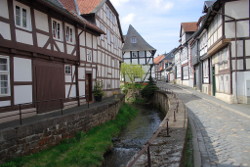
Goslar has a rich cultural, political and industrial history.
Salian Emperor Henry I founded the town in the 10th century after the discovery of silver deposits in the nearby Rammelsberg.
The wealth derived from silver mining brought Goslar the status of an Imperial City, which attracted the interest of the Holy Roman Emperor.
The medieval Imperial Palace (Kaiserpfalz Goslar) was built in the 11th century and became a summer residence for the emperors, especially
Henry III of Germany who visited his favourite palace about twenty times. Henry's heart is buried in Goslar, his body in the family
vault in Speyer Cathedral.
During your stay in Golsar you will experience guided tours through:
Kaiserpfalz Imperial Palace
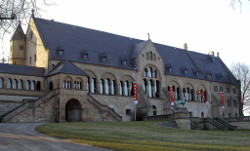
Kaiserpfalz, The Imperial Palace, built between 1040 and 1050 during the reign of Heinrich III, is a unique secular architecture monument.
For more than 200 years German and European history was made here. In the St. Ulrich Chapel at the south end a stone sarcophagus with the figure
of Heinrich III on the cover houses the gold capsule containing the heart of the emperor, who died in 1056.
In the late 19th century both the Palace and the Chapel were renovated extensively and the interior of the Palace upper hall was decorated
with monumental murals by H. Wislicenus. The ground floor has an extensive exhibition of itinerant imperial rule. The Imperial Palace is a
“must” for every Goslar visitor.
World Heritage Rammelsberg Mining Museum
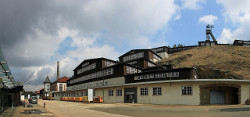
The ore mines of the Rammelsberg are the only mines in the world which were in uninterrupted operation for over 1000 years.
It and the medieval Old Town of Goslar with the Imperial Palace were placed on the UNESCO World Heritage List in 1992. Ten centuries of mining
history are documented in the Rammelsberg, which shut down in 1988, leaving a large inventory of mining monuments: the slag heaps (10th century),
the Rathstiefste Gallery (one of the oldest and best maintained galleries of German mining, 12th century), the Feuergezähe Vault
(oldest underground stone-masonry mine chamber in Europe, 13th century), the Maltermeister Tower (the oldest above ground structure of German
mining, 15th century), the Roeder Gallery (18th/19th century) with two original water wheels, and the above ground mining plant from the 1930’s.
With its wealth of nearly 30 million tonnes of ore the Rammelsberg influenced the history and development of the town of Goslar.
The silver- and copper-rich Rammelsberg gave Heinrich II the impetus to establish a royal palatinate here in the 11th century;
in 1009 the first imperial diet was held in Goslar. Goslar was a favourite residence of German kings and emperors until 1253.
Trade in metals led to membership in the Hanseatic League.
Pictures: Wikipedia, Y.Shishido, Tobias Helfrich, Norbert Kaiser
Departure to Göttingen: 18:00
Arrival Göttingen: 19:00
Price: 50 Euro per Person + VAT
Abstract Upload
[updated 27.06.2016]
Deadlines exceeded, abstract submission is closed now!
Deadlines:
Lectures: 30 April 2016
Posters: 24 June 2016
Registration
[updated 17.02.2016]
Fees
[updated 15.02.2016]
Status
|
until 5 June 2016 |
after 5 June 2016 |
| Euro Fed Lipid Members* and Employees of member companies |
350 Euro |
400 Euro |
Non-Members
|
400 Euro |
450 Euro |
Euro Fed Lipid student member with poster presentation** (proof needed)
|
100 Euro |
150 Euro |
all other students
(proof needed)
|
150 Euro |
200 Euro |
* Euro Fed Lipid Members are direct members as well as members of AOCS (European Section), Czech Chemical Society (Oils & Fats Group),
DGF, GERLI, Greek Lipidforum, KNCV (Oils & Fats Group), Nordic Lipidforum, METE (Vegetable Oil Division), Polish Food Technologists
Society, (Oils & Fats Section) SCI (Lipids Group), SFEL, SISSG or YABITED
** The student status is granted to undergraduate, postgraduate and Ph.D. students. Please provide a suitable proof of your student
status with the registration (e.g. copy of the student card, confirmation of the institute or similar).
Registration fees are not subject to value added tax (tax exemption according Paragraph 4 Nr. 22a UStG).
The registration fee includes:
-Entry to the scientific programme, poster sessions
-Book of abstracts
-List of participants
-Coffee Break beverages
-Poster Receptions
-Lunches
After registration you will receive an invoice.
Paying by Bank Transfer:
Please transfer the total fees (free of bank commission) to:
Euro Fed Lipid e.V.
Deutsche Bank, Frankfurt/ Main
Account No. 2401 610 00
BLZ 500 700 24 (Routing Number)
IBAN DE 71 500 700 240 240 1610 00
BIC/SWIFT: DEUTDEDBFRA
Please quote your reference number.
Paying by Credit Card
We accept Visa, MasterCard and AMEX
Cancellation Policy
Cancellations received on or before 5 June 2016 will be refunded minus a 30 Euro processing fee.
After that date until 28 June 2016, 50% of the registration fee will be refunded. There will be no refund for cancellations
after 28 June 2016 or No-Shows. Substitute participants can be named anytime without costs.
If the congress is cancelled for whatever reason, paid fees will be refunded.
Further recourse is excluded.
The Venue/Accommodation
[updated 16.03.2016]
The congress takes place at the
"Alte Mensa" of University of Göttingen
Wilhelmplatz
37073 Goettingen
Germany
Accommodation:
120 hotel rooms have been reserved in different categories for your convenience.
Intercity Hotel
Single Room: 65€/night
Double Room 95€/night incl. breakfast
Reserve your room until 26 May 2016 referring to "ISPL-2016"
Phone: +49/ 551/5211-0
Fax: +49/ 551/5211-500
goettingen@intercityhotel.de
fully booked:
Hotel Stadt Hannover
Single Room: 87€
Double Room, single use: 102€ incl. breakfast
Reserve your room until 2 June 2016 referring to "ISPL-2016"
Phone: +49/551/547960
Fax: +49/551/4570
info@hotelstadthannover.de
To find more hotels and book a room please follow this link:
http://germany.nethotels.com/info/goettingen/events/plantlipids2016/default_en.htm
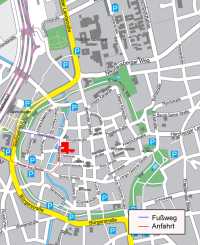 Travel Information:
Travel Information:
The nearest international airport is Hannover, but Frankfurt International airport offers more flight options.
Both airports are connected to Goettingen by high-speed ICE train connections. Hannover: 1 hrs, Frankfurt: 2 hrs
Train schedules and tickets:
http://www.bahn.de/p_en/view/index.shtml
City Map of Goettingen
Congress Dinner
[updated 15.02.2016]
The Conference dinner takes place 7 July, 19:30 at Restaurant "Bullerjahn", which is located in the cellars of the old town hall, Markt 9
a four course summer menu will be served. Drinks are included.
Registration required
Price: 60 € plus VAT
Goettingen
[updated 28.10.2014]
Goettingen, the university city on the Leine river steeped in tradition,
is situated right in the middle of Germany. This city, with approximately 129.000
inhabitants of which more than 25.000 are students, is characterised by a creative flair and a unique atmosphere.
|
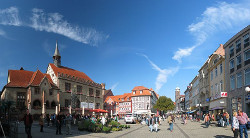 Wikipedia, Daniel Schwen
Wikipedia, Daniel Schwen |
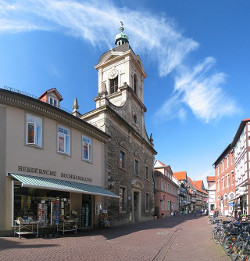
Wikipedia, Daniel Schwen
|
The village "Gutingi", to which the city goes back, was first mentioned in 953 in a document by Emperor Otto I. Today's old town combines
in a charming way the memory of the medieval merchant community (member of the Hanseatic League 1351-1572) with the ambience of a
modern business location.
|
With 13 faculties the Georg-August-University, founded in 1737, is well represented in nearly all scientific disciplines. Also,
more than 40 Nobel Prize winners are associated with its name.
|
 Wikipedia, Frank Schulenburg
Wikipedia, Frank Schulenburg |

Wikipedia, Ajburk
|
Goose Lizzy is a fountain which was erected in 1901 in front of the medieval town hall of Goettingen. Although rather small in size, the
fountain is the most well-known landmark of the city. Today, it is an essential part of the graduation celebrations for every student
who finishes a doctorate to climb the fountain and to kiss the statue of the goose girl.
|
Organiser
[updated 25.07.2014]
European Federation for the Science and Technology of Lipids e.V.
Postfach 90 04 40
60444 Frankfurt/Main
Phone: +49 69/79 17-533
Fax: +49 69/79 17-564
E-Mail:
info@eurofedlipid.org

 Goslar has a rich cultural, political and industrial history.
Goslar has a rich cultural, political and industrial history. Kaiserpfalz, The Imperial Palace, built between 1040 and 1050 during the reign of Heinrich III, is a unique secular architecture monument.
For more than 200 years German and European history was made here. In the St. Ulrich Chapel at the south end a stone sarcophagus with the figure
of Heinrich III on the cover houses the gold capsule containing the heart of the emperor, who died in 1056.
Kaiserpfalz, The Imperial Palace, built between 1040 and 1050 during the reign of Heinrich III, is a unique secular architecture monument.
For more than 200 years German and European history was made here. In the St. Ulrich Chapel at the south end a stone sarcophagus with the figure
of Heinrich III on the cover houses the gold capsule containing the heart of the emperor, who died in 1056.
 The ore mines of the Rammelsberg are the only mines in the world which were in uninterrupted operation for over 1000 years.
It and the medieval Old Town of Goslar with the Imperial Palace were placed on the UNESCO World Heritage List in 1992. Ten centuries of mining
history are documented in the Rammelsberg, which shut down in 1988, leaving a large inventory of mining monuments: the slag heaps (10th century),
the Rathstiefste Gallery (one of the oldest and best maintained galleries of German mining, 12th century), the Feuergezähe Vault
(oldest underground stone-masonry mine chamber in Europe, 13th century), the Maltermeister Tower (the oldest above ground structure of German
mining, 15th century), the Roeder Gallery (18th/19th century) with two original water wheels, and the above ground mining plant from the 1930’s.
The ore mines of the Rammelsberg are the only mines in the world which were in uninterrupted operation for over 1000 years.
It and the medieval Old Town of Goslar with the Imperial Palace were placed on the UNESCO World Heritage List in 1992. Ten centuries of mining
history are documented in the Rammelsberg, which shut down in 1988, leaving a large inventory of mining monuments: the slag heaps (10th century),
the Rathstiefste Gallery (one of the oldest and best maintained galleries of German mining, 12th century), the Feuergezähe Vault
(oldest underground stone-masonry mine chamber in Europe, 13th century), the Maltermeister Tower (the oldest above ground structure of German
mining, 15th century), the Roeder Gallery (18th/19th century) with two original water wheels, and the above ground mining plant from the 1930’s.








